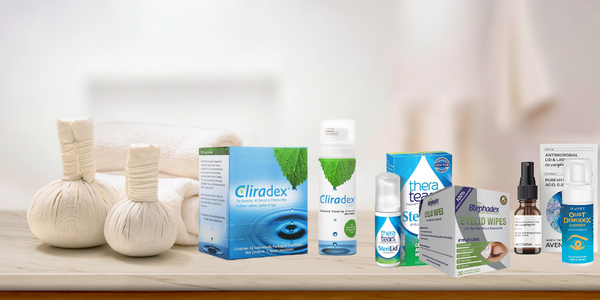It’s a common but frustrating problem: red, swollen eyelids; heat and pain radiating from the inflammation; dry skin flaking around your eyelashes. Blepharitis, or swelling of the eyelid, is both uncomfortable and unsightly. Millions of Americans suffer from it every year.1
Though not usually medically serious, blepharitis can cause damage to your eyes if it becomes too severe. Even without permanent ocular damage, blepharitis is still aggravating to try to manage and can interfere with everyday activities like reading, driving, and even resting.
What Causes the Inflammation that is Irritating your Eyes?
In the case of posterior blepharitis, blockages in your meibomian glands lead to the inflammation. Meibomian glands are the pores along the edges of your eyelids. They secrete protective lipids that prevent your eyes from drying out. Certain infections, such as bacteria or Demodex mite (eyelash mite) infestations, can also cause these blockages.
In anterior blepharitis, irritants or skin disorders trigger a local immune reaction that causes the redness and swelling.2
Alternative Approaches for Addressing Eyelid Irritation
If you are like many Americans today, you want to be well-informed about the products you put on your face. There has been a movement toward natural, plant-based cosmetics and dermatologic products as consumers wish to limit their exposure to harsh chemicals. Alternative approaches, if used properly, can provide a safe, affordable, and convenient means for addressing certain conditions at home.
1 – Warm Compresses
One such approach is to apply a warm compress to the affected eye. This is a simple way to soothe the area and help unclog the meibomian glands. It can also be beneficial to gently massage the lower eyelids in an upward motion and the upper eyelids in a downward motion while warming the area.3
2 – Eyelid Cleanser
For more severe or long-lasting cases of blepharitis, a deep cleaning product may be necessary to clear away the underlying cause of the inflammation. One compound identified recently which shows exciting eye health benefits is 4-terpineol, which is the most important ingredient in tea tree oil. Terpinen-4-ol, or 4-terpineol, is a type of terpene alcohol, a class of organic molecule found in plant resins. Terpenes tend to have strong odors and are used by plants to ward off parasites. Scientists have found that 4-terpineol has many powerful properties that target the various causes of blepharitis, such as demodex mites.4
Cliradex towelettes were developed with the optimal concentration of 4-terpineol to eliminate tough-to-kill demodex mites while being safe enough to use for the length of time required to clear an infestation. They help reduce the redness, swelling, and soreness associated with blepharitis.
Proper Eye Hygiene – Vital for Avoiding Eyelid Irritation

To avoid blepharitis in the first place, eyelid hygiene is the key. A gentle daily wash of your face and eyes can keep your glands and ducts open and work properly. Cleaning your eyelids and the area around your eyes can also help remove irritants like dust, pollen, and viruses. Using a specially-formulated, plant-based cleanser such as Cliradex Light each day can keep inflammation-causing pathogens at bay.
From daily hygiene to addressing the toughest cases of blepharitis, Cliradex has you covered.
References:
- Lemp MA, Nichols KK. Blepharitis in the United States 2009: a survey-based perspective on prevalence and treatment. The ocular surface. 2009;7(2 Suppl):S1-s14.
- Eberhardt M, Rammohan G. Blepharitis. In: StatPearls. Treasure Island (FL): StatPearls Publishing
- Benitez-Del-Castillo JM. How to promote and preserve eyelid health. Clinical ophthalmology (Auckland, NZ). 2012;6:1689-1698.
- Tighe S, Gao YY, Tseng SC. Terpinen-4-ol is the Most Active Ingredient of Tea Tree Oil to Kill Demodex Mites. Translational vision science & technology. 2013;2(7):2.




